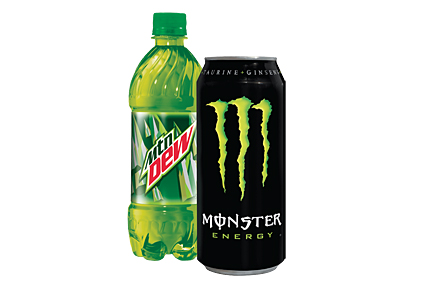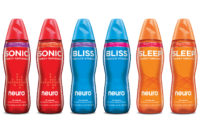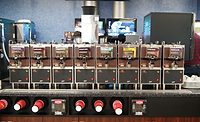The environment is looking up for convenience stores, and particularly for beverages sold in the channel. The channel posted sales gains of 4.4 percent for the latest 52 weeks ending July 15, versus a year ago, which resulted in approximately a $5.5 billion increase in business, reports Chicago-based market research firm SymphonyIRI Group.
Total beverage sales were up 2.7 percent for the period versus a year ago, with many categories posting double-digit gains, SymphonyIRI reports. Energy drinks boasted a 17.8 percent gain, sports drinks grew 11.6 percent, ready-to-drink (RTD) teas increased 10.6 percent, wine rose 23 percent, and spirits grew 16.2 percent in the 52 weeks ending July 15, compared with the previous year. In addition, bottled water sales grew
7.7 percent, beer sales were up 6.7 percent, carbonated beverages showed a 4.5 percent gain and bottled juice posted a 4 percent gain during the time period versus a year ago.
“You have a few with double-digit growth, but when you have beer and carbonated beverages that have solid mid-figure percent sales increases, that’s off the charts,” says Matt McCourt, consultant of convenience and spirits for retail client solutions with SymphonyIRI. “They haven’t had that type of growth in a while.”
Beverage categories in the convenience channel also took share from other channels, excluding the bottled water category, which was flat compared to a year ago, SymphonyIRI reports. Sports drinks showed the largest share increase of 2.4 points versus a year ago. RTD teas and coffees reported a 1.5 share points gain, while bottled juice and spirits were both up a share point. Carbonated beverages and wine both grew just shy of one share point, while beer increased a little more than half a share point.
“When you are growing share, you obviously are growing your business,” McCourt says. “Beverage companies have been trying to challenge and grow their business, and they have been reinvesting.”
Convenience stores are competing against every other channel to sell drinks, but the channel’s advantage is its numerous convenient locations.
“If you go to other competing channels, who doesn’t sell drinks?” asks Jeff Leonard, vice president of industry advocacy for the National Association of Convenience Stores (NACS), Alexandria, Va.
“… That’s good for customers and manufacturers, but the challenge for retailers is that convenience stores are really selling hassle-free.”
One way beverage companies have been drawing attention to their brands in the channel is through sales promotions. Although sales promotions dropped in the first part of the year for tobacco — one of the leading categories in convenience stores — beverage companies have significantly increased their promotions, McCourt says. Energy drink promotional dollars were up more than 32 percent, which helped to fuel its nearly 18 percent sales growth, according to SymphonyIRI data. Bottled water also increased promotions 27 percent; RTD teas and coffees increased promotions more than 20 percent; and sports drinks grew promotions 8 percent. Beer promotions were down 3 percent, and carbonated beverage sales promotions decreased slightly at less than 1 percent, the market research firm reports. On the other hand, cigarette sales remained flat versus a year ago, and their promotional dollars dropped almost 25 percent compared to the prior year.
“What you saw is manufacturers and suppliers working with retailers to drive more promotions to get more people into the stores,” McCourt says.
Because of the partnership between beverage-makers, suppliers and retailers, many beverages also are in SymphonyIRI’s Top 15 fastest-moving items in convenience stores by unit, with carbonated beverages and energy drinks driving much of that movement. Mountain Dew is the third fastest mover in unit sales followed by Monster Energy as the fifth, SymphonyIRI reports. Coca-Cola, Pepsi and Dr Pepper in 20-ounce bottles also made the list, along with Red Bull in 8-ounce and 12-ounce cans. In addition, Bud Light lager in 24-ounce cans made the Top 15 list.
Channel challenges
Despite growth, the convenience store environment is not without its hurdles. Willard Bishop, Barrington, Ill., noted more modest gains for the channel last year with 2.4 percent growth.
“They continue to prove they are recession proof and continue to tick along with modest growth,” says Paul Weitzel, managing partner at the research firm. “But, unlike past years, all of the growth is due to price inflation. Recent data suggests units are down
1 percent to 2 percent for most chains.”
Euromonitor International, Chicago, also reports that the channel has seen some sales growth with relatively flat store growth, which generally means that the stores left standing are stronger, says Kailing Cai, U.S. research associate.
“But it’s a tough space,” she explains. “The majority of c-stores are independently owned, so you can see a reflection of the economic struggle still taking place here. Gas prices have fallen from their peak earlier this year, so there has been a bit of relief. However, despite higher value sales of fuel compared with 2011, many operators have seen volumes decline, indicating a consumer more sensitive to gas prices, which does not bode well for other sales.”
As with last year, in-store sales for convenience stores with fuel stations have not grown as much as in standalone convenience stores, likely because the pressure at the pump increases consumer reluctance to go inside and spend more money.
“Average spend per visit is down, and impulse purchases are more tempered this year,” Cai says.
Blue-collar workers, who are traditionally core convenience store customers, are still in a weak spot as well. Unemployment is varying regionally, so stores operating in areas with higher rates of unemployment are disproportionately affected by lower traffic and lower spend, she says.
“To expand their customer base, c-stores are increasingly focusing on capturing females and families who often shop at c-stores for different purposes and are seeking a different store experience as well,” Cai says.
Driving traffic
Industry researchers report that convenience store traffic is flat to down. Willard Bishop shows that traffic is down 1 to 2 percent in the channel. The NPD Group, Port Washington, N.Y., saw consumer traffic for the 12 months ending June 2012 as flat versus last year. However, a little gas price relief contributed to some improvement in the second quarter, which came mostly in the form of increased visit frequency of 1.2 percent in the quarter, the company says.
“Historically, rising gas prices erode share of wallet available for c-store purchases as well as drive gas purchase occasions to alternate retailers like big box stores with discount gasoline,” says David Portalatin, executive director of industry analysis with The NPD Group. “Some relief over the last couple of months has helped consumer traffic in the convenience channel.”
A typical convenience store receives approximately 1,100 customers, and about 300 to 400 are at the pump, NACS’ Leonard says.
“You have a chance when someone is at the pump filling up to get them inside the store or to find ways to get the store to them at the pump,” he says.
Non-alcohol beverages are the primary driver of convenience store traffic with 60 percent of consumers making a non-alcohol beverage purchase during their last convenience store visit, The NPD Group’s Portalatin says. With convenience stores as a destination for food and drink, the total beverage category, including packaged, dispensed, frozen dispensed and milk, accounted for 29.9 percent of the channel’s in-store sales last year, NACS’ Leonard says.
The beverage category also stands to benefit from an increase in midday traffic of 5 percent and afternoon traffic of 2 percent a day as more consumers turn to convenience stores for meal occasions, according to The NPD Group. Food prepared on-site as well as single-serve, pre-packaged foods are increasing in sales, Portalatin says.
Many convenience store chains are in the midst of remodeling or redesigning their stores to give greater focus to grocery and foodservice items, blurring channel lines and competing even more with supermarkets, quick-service restaurants and drug stores.
“There is definitely an increased emphasis on the convenience factor, on making their stores the convenient place to shop, and keeping in mind the ease of the visit in designing store layouts,” Euromonitor’s Cai says. “Having quality foodservice and fresh items can help a store distinguish itself from competitors and get customers in the door, especially when the rest of the stock is otherwise identical, and a lot of marketing has been focused on raising awareness of the freshness, quality and value of those items.”
Foodservice still remains a difficult area for most convenience stores. “Foodservice requires a long-term commitment and unrelenting focus on execution,” Willard Bishop’s Weitzel says. “[They] have to work through the start-up pains and learning curves [which is] not easy with day-part traffic and limited in-store labor.”
Convenience stores also are working to drive more traffic into their locations with the use of programs such as loyalty or reward cards.
“I expect this will be the next big thing for c-stores,” Weitzel says. “They have held off due to the cost to set up, which requires upgraded [point-of-sale] systems ... but enough chains now feel the time is right to make the necessary investment — an investment they believe will drive greater trips and larger baskets across more people.
“I think the loyalty push and potential one-to-one marketing opportunity is a potential game changer for chains who can do it well,” he adds.
Willard Bishop also thinks that smartphones will be another useful tool with targeted promotions to shoppers at the pump with incentives to get them into the stores.
Euromonitor also sees chains investing more in shopper insights and loyalty programs beyond fuel discounts, trying to segment consumers into more targeted groups and looking for those repeat shoppers.
“Stores are promising more, and they have to make sure they can deliver when the customer starts to have higher expectations,” Cai says. “Operators must be very careful in managing their inventory to avoid out-of-stocks on popular items, which can be very damaging to shopper loyalty.” BI




